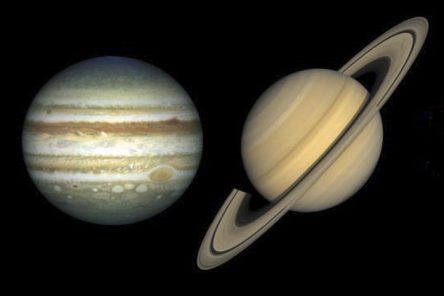
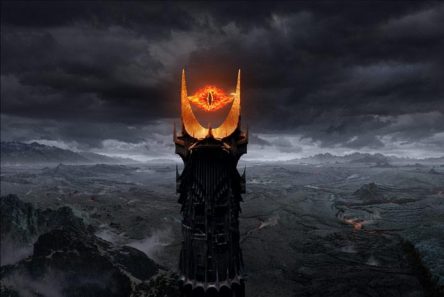
“The night sky was still dim and pale. There, peeping among the cloud-wrack above a dark tor high up in the mountains, Sam saw a white star twinkle for a while. The beauty of it smote his heart, as he looked up out of the forsaken land, and hope returned to him. For like a shaft, clear and cold, the thought pierced him that in the end the Shadow was only a small and passing thing: there was light and high beauty forever beyond its reach.”- J.R.R. Tolkien, The Return of the King
These are troubled times my friends and while we might not have the Dark Lord, Sauron breathing down our necks (yet), the Tolkien references just kind of wrote themselves for this month’s edition of The Night Sky blog as we see the return of the king of the planets, Jupiter, and the ringed wonder of the solar system, Saturn, to our evening sky. Let’s step outside and take a look.
WHEN AND WHERE TO LOOK
The great thing about this month’s featured objects is that they sit side by side in our night sky and are so bright, that you can’t miss them, all you need to know is when and where to look.
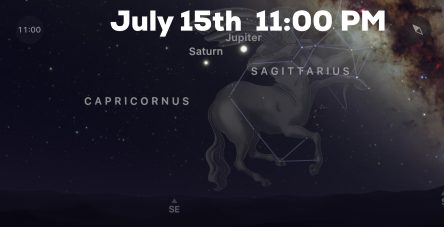 During the first half of the month Jupiter and Saturn rise about an hour after sunset and will have cleared the horizon well enough to be spotted without difficulty at about 11 PM local time. So, at around this time during the early portions of July, go outside and face towards the southeast, there you will see the pair hanging in the sky. Jupiter is about 15 degrees (that’s about one and a half fist widths held out at arm’s length) above the SE horizon and is shining brightly at a magnitude of -2.7. During the first half of July, Saturn sits just 6 degrees east of Jupiter, a little bit lower to its left and is slightly dimmer. If you watch them over the first couple of weeks you’ll notice that the gap between the two widens to 8 degrees by the night of July 14th. What’s up with that? Well, the very word, “planet”, comes from the Ancient Greek and it means “wanderer”. The Greeks noticed that, unlike all the other star-like objects in the night sky, there were certain ones that tended to move around a bit with respect to the other star-like dots in the sky. They assumed these wanderers must be gods, so they gave them the names of the deities from their pantheon. But this motion upon the sky is not real, it’s an “apparent motion”. It’s due to the fact that all of the planets are indeed in motion and the inner planets are moving faster than the outer ones. So, as the Earth overtakes an outer planet as we move about in our orbit around the Sun, the outer planet will appear to us as moving upon the sky first in one direction and then backwards in another as we pass it by. We call this backwards apparent motion, “retrograde motion” and Jupiter appears to be moving briskly across the sky. Of course, astrologers will try and tell you that a planet in retrograde has all kinds of negative connotations but I’m here to tell you that that’s a bunch of hogwash, ignore it.
During the first half of the month Jupiter and Saturn rise about an hour after sunset and will have cleared the horizon well enough to be spotted without difficulty at about 11 PM local time. So, at around this time during the early portions of July, go outside and face towards the southeast, there you will see the pair hanging in the sky. Jupiter is about 15 degrees (that’s about one and a half fist widths held out at arm’s length) above the SE horizon and is shining brightly at a magnitude of -2.7. During the first half of July, Saturn sits just 6 degrees east of Jupiter, a little bit lower to its left and is slightly dimmer. If you watch them over the first couple of weeks you’ll notice that the gap between the two widens to 8 degrees by the night of July 14th. What’s up with that? Well, the very word, “planet”, comes from the Ancient Greek and it means “wanderer”. The Greeks noticed that, unlike all the other star-like objects in the night sky, there were certain ones that tended to move around a bit with respect to the other star-like dots in the sky. They assumed these wanderers must be gods, so they gave them the names of the deities from their pantheon. But this motion upon the sky is not real, it’s an “apparent motion”. It’s due to the fact that all of the planets are indeed in motion and the inner planets are moving faster than the outer ones. So, as the Earth overtakes an outer planet as we move about in our orbit around the Sun, the outer planet will appear to us as moving upon the sky first in one direction and then backwards in another as we pass it by. We call this backwards apparent motion, “retrograde motion” and Jupiter appears to be moving briskly across the sky. Of course, astrologers will try and tell you that a planet in retrograde has all kinds of negative connotations but I’m here to tell you that that’s a bunch of hogwash, ignore it.
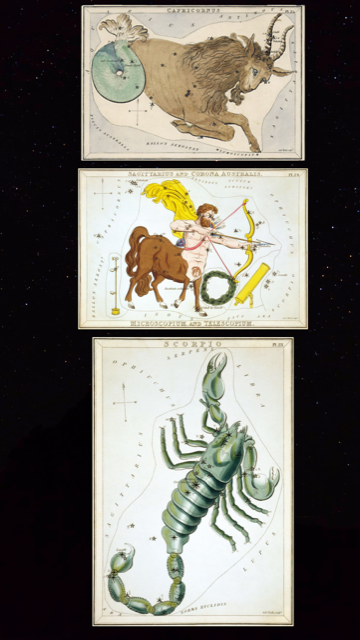 Jupiter can be found in the eastern edges of the constellation of Sagittarius, which represents the half man/half horse centaur from Greek mythology. But don’t go connecting the dots of the stars within the constellation and expect to see the outline of such a creature because it just ain’t gonna happen. However, you should try and look for the familiar asterism (an unofficial star pattern made up from stars within one or more of the official constellations) known as the “teapot” within Sagittarius and located about 10 or 15 degrees to the immediate west of Jupiter. Saturn on the other hand, resides this month on the western edge of Capricornus one of the zodiacal constellations and said to represent a “sea goat”, whatever the heck that is. Anyways, don’t expect to see much here either as the stars that make up Capricornus are all pretty faint. If you want to see a constellation that actually looks like what it’s supposed to, then use Jupiter to guide your eye on through the teapot and then a bit more to the west in order to see Scorpius just on the western side of Sagittarius. In fact, if you go out at around 9:30 PM or 10 PM local time and look to the SE, you will see Scorpius’s alpha star, Antares, placed about 10 degrees above the horizon. Look for it again while you are outside taking in the two planets and the outlines of the scorpion can be plainly seen if your sky is sufficiently dark.
Jupiter can be found in the eastern edges of the constellation of Sagittarius, which represents the half man/half horse centaur from Greek mythology. But don’t go connecting the dots of the stars within the constellation and expect to see the outline of such a creature because it just ain’t gonna happen. However, you should try and look for the familiar asterism (an unofficial star pattern made up from stars within one or more of the official constellations) known as the “teapot” within Sagittarius and located about 10 or 15 degrees to the immediate west of Jupiter. Saturn on the other hand, resides this month on the western edge of Capricornus one of the zodiacal constellations and said to represent a “sea goat”, whatever the heck that is. Anyways, don’t expect to see much here either as the stars that make up Capricornus are all pretty faint. If you want to see a constellation that actually looks like what it’s supposed to, then use Jupiter to guide your eye on through the teapot and then a bit more to the west in order to see Scorpius just on the western side of Sagittarius. In fact, if you go out at around 9:30 PM or 10 PM local time and look to the SE, you will see Scorpius’s alpha star, Antares, placed about 10 degrees above the horizon. Look for it again while you are outside taking in the two planets and the outlines of the scorpion can be plainly seen if your sky is sufficiently dark.
Okay, there are two dates you should mark down on your calendar this month for these respective planets: July 14th for Jupiter and July 20th for Saturn. These are the dates that each planet reaches opposition. 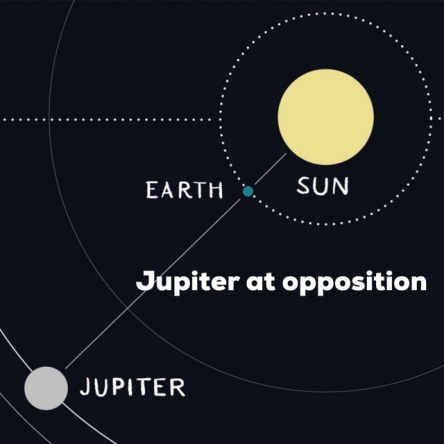 Opposition is simply when the orbit of the Earth and an outer planet align in such a way that the Sun appears on the opposite side of the sky from said planet. Look at it this way: on the date of the alignment, if you were in a spaceship “above” the solar system and looking “down” you would see an alignment like this: Sun->Earth->Planet. On these occasions, the planet rises around sunset, stays up all night and, because we are at our closest distance to it around this time, it is well placed for looking at with a telescope. And believe me, this is where having access to a telescope is a nice commodity, because of all the planets to observe, these two are the best for viewing with optical aid. Due to the pandemic, the Central Arkansas Astronomical Society will not be hosting their usual summer star parties, however, thanks to the efforts of CAAS and the Arkansas Space Grant Consortium, you can now check out telescopes from all of the Central Arkansas Library System branches as well as from a few other libraries within the state. Still can’t get a telescope? No worries. Just visit the websites of observatories such as the McDonald Observatory located in west Texas. Many of these sites will be hosting virtual star parties on various nights and you can join in (for free) and watch livestreams of video feeds from their telescopes. And I would be very much surprised if they did not show you Jupiter and Saturn when they do. NOTE: Mid to late summer is monsoon season in west Texas so there is a good chance that a scheduled event from the McDonald Observatory could get rained out, so be patient and check with websites such as Cloudy Nights or Sky and Telescope to find others.
Opposition is simply when the orbit of the Earth and an outer planet align in such a way that the Sun appears on the opposite side of the sky from said planet. Look at it this way: on the date of the alignment, if you were in a spaceship “above” the solar system and looking “down” you would see an alignment like this: Sun->Earth->Planet. On these occasions, the planet rises around sunset, stays up all night and, because we are at our closest distance to it around this time, it is well placed for looking at with a telescope. And believe me, this is where having access to a telescope is a nice commodity, because of all the planets to observe, these two are the best for viewing with optical aid. Due to the pandemic, the Central Arkansas Astronomical Society will not be hosting their usual summer star parties, however, thanks to the efforts of CAAS and the Arkansas Space Grant Consortium, you can now check out telescopes from all of the Central Arkansas Library System branches as well as from a few other libraries within the state. Still can’t get a telescope? No worries. Just visit the websites of observatories such as the McDonald Observatory located in west Texas. Many of these sites will be hosting virtual star parties on various nights and you can join in (for free) and watch livestreams of video feeds from their telescopes. And I would be very much surprised if they did not show you Jupiter and Saturn when they do. NOTE: Mid to late summer is monsoon season in west Texas so there is a good chance that a scheduled event from the McDonald Observatory could get rained out, so be patient and check with websites such as Cloudy Nights or Sky and Telescope to find others.
OBSERVING JUPITER AND SATURN WITH BINOCULARS OR A TELESCOPE
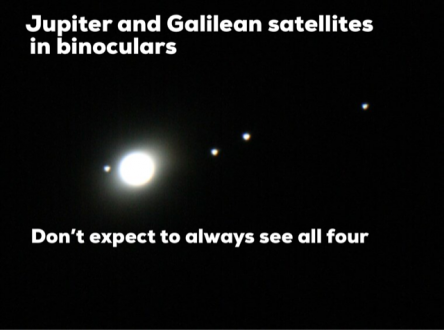 A pair of binoculars will not reveal surface details on either of these planets, nor will it reveal the rings of Saturn (except as a bulging midsection to an otherwise star-like point). However, you can see Saturn’s beautiful golden hue in binocs and, if it’s positioned just right, you might even catch a glimpse of the planet’s largest moon as a star-like dot.
A pair of binoculars will not reveal surface details on either of these planets, nor will it reveal the rings of Saturn (except as a bulging midsection to an otherwise star-like point). However, you can see Saturn’s beautiful golden hue in binocs and, if it’s positioned just right, you might even catch a glimpse of the planet’s largest moon as a star-like dot.
Looking at Jupiter with binoculars will also show its four largest moons: Io, Europa, Ganymede, and Callisto. Astronomers call them “Galilean satellites” because Italian astronomer (and all-around polymath) Galileo Galilei was the first to spot them in a crude little telescope he made himself. It was his observations of these tiny little worlds orbiting their master that helped show that the Earth was not the center of all things and that there are other worlds with objects orbiting around them as well. You can reproduce Galileo’s observations on your own with just binoculars. Watch them from night to night and see how they move about in their orbits around Jupiter.
Telescopes are where all the good eye candy is to be had, everything I just mentioned as well as things like the cloud belts and storms on Jupiter as well as the majestic rings of Saturn. Stunning!
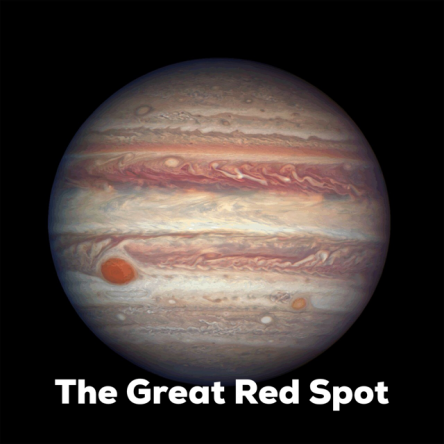 Here’s what I suggest you do if you have a telescope. Spend a good few minutes with each planet and then switch back and forth. You really need to spend a bit of time staring at Jupiter before you begin to get good views. Why? Well, staring at it for several minutes allows your eyes to adjust to its brightness and it gives you an opportunity to possibly catch good moments of seeing. In astronomy speak, “seeing” is a measure of the blurring and twinkling that our atmosphere can produce when looking at celestial objects in a telescope. The atmosphere is always in motion, even if you have clear skies and all seems nice and calm. Because of all of this churning motion of the gases above your head, there will be moments where seeing is good and moments where it seems as though you are looking at the planet from the bottom of a swimming pool. Be patient, let your eyes adjust, and let the atmosphere do its thing. By switching back and forth, you might get the chance to see changes in Jupiter’s cloud patterns. And keep an eye for the giant anticyclone we all know and love as the Great Red Spot. You can usually find timetables in astronomy magazines or online that will give you the transit times as when it will come into view. Ever since consistent observations of the Great Red Spot began in the late 1800’s astronomers have noticed a shrinking trend going on. At its maximum, you could fit at least three Earth’s inside the storm, today, you might squeeze in just one. It has shrunk even more dramatically within our lifetimes and astronomers are still puzzled as to what’s going on with it. Will it disappear forever? We don’t know for sure but most astronomers think that it’s likely to be with us for some time to come, I just know that we are all excited to see what the Great Red Spot gets up to this season.
Here’s what I suggest you do if you have a telescope. Spend a good few minutes with each planet and then switch back and forth. You really need to spend a bit of time staring at Jupiter before you begin to get good views. Why? Well, staring at it for several minutes allows your eyes to adjust to its brightness and it gives you an opportunity to possibly catch good moments of seeing. In astronomy speak, “seeing” is a measure of the blurring and twinkling that our atmosphere can produce when looking at celestial objects in a telescope. The atmosphere is always in motion, even if you have clear skies and all seems nice and calm. Because of all of this churning motion of the gases above your head, there will be moments where seeing is good and moments where it seems as though you are looking at the planet from the bottom of a swimming pool. Be patient, let your eyes adjust, and let the atmosphere do its thing. By switching back and forth, you might get the chance to see changes in Jupiter’s cloud patterns. And keep an eye for the giant anticyclone we all know and love as the Great Red Spot. You can usually find timetables in astronomy magazines or online that will give you the transit times as when it will come into view. Ever since consistent observations of the Great Red Spot began in the late 1800’s astronomers have noticed a shrinking trend going on. At its maximum, you could fit at least three Earth’s inside the storm, today, you might squeeze in just one. It has shrunk even more dramatically within our lifetimes and astronomers are still puzzled as to what’s going on with it. Will it disappear forever? We don’t know for sure but most astronomers think that it’s likely to be with us for some time to come, I just know that we are all excited to see what the Great Red Spot gets up to this season.
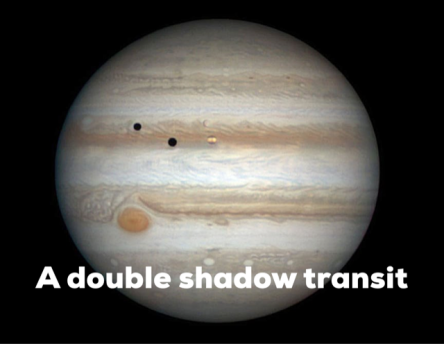 Also, be on the lookout for transits and occultations of Jupiter’s Galilean satellites. A transit is when a moon passes across the face of the planet, casting a shadow onto the cloud deck below; occultations are eclipses where a moon passes behind the planet, is blocked from sight, and then emerges on the other side later. There are apps that will tell you what the moons are doing and where they are for any given moment. Sky and Telescope has one for both Jupiter and Saturn. Likewise, you can just visit their website for this kind of information as well. Believe me, seeing the shadow of a moon (or sometimes even two) is a spectacular sight and it gives you an immediate sense of 3 dimensionality to the scene.
Also, be on the lookout for transits and occultations of Jupiter’s Galilean satellites. A transit is when a moon passes across the face of the planet, casting a shadow onto the cloud deck below; occultations are eclipses where a moon passes behind the planet, is blocked from sight, and then emerges on the other side later. There are apps that will tell you what the moons are doing and where they are for any given moment. Sky and Telescope has one for both Jupiter and Saturn. Likewise, you can just visit their website for this kind of information as well. Believe me, seeing the shadow of a moon (or sometimes even two) is a spectacular sight and it gives you an immediate sense of 3 dimensionality to the scene.
SPECIAL OBSERVING TREAT
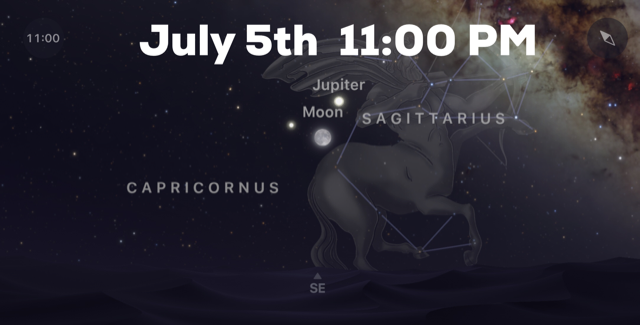 On the night of July 5th, look for the full moon sitting amongst the two planets. Jupiter will be to the moon’s upper right while Saturn is off the moon’s left. It will be a lovely sight.
On the night of July 5th, look for the full moon sitting amongst the two planets. Jupiter will be to the moon’s upper right while Saturn is off the moon’s left. It will be a lovely sight.
JUST THE FACTS
Here are a few quick facts regarding each planet, some things to think about as you are outside looking at them.
JUPITER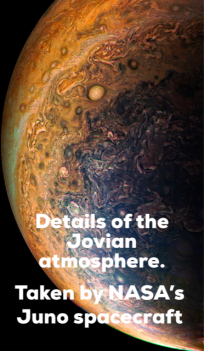
- Jupiter is the fifth planet in our solar system and is easily the largest, having a diameter of some 88,000 miles, it has enough volume to hold 1,325 Earths inside it.
- Its average distance from the Sun is approximately 483 million miles. I say “average distance” because the orbital shape of the planets is not a perfect circle, it’s and ellipse. Consequently, the distance from the Sun is always changing.
- Jupiter is made up of gas, there is no solid surface for you to land on. Its main components are the gases hydrogen and helium, the same stuff the Sun is made of. Some people state that Jupiter is a “failed star”, meaning if it had gotten just a bit bigger, it too would have become a Sun. Welllll, you would actually need about 100 times more mass for that to happen and then you would only have a dinky red dwarf star.
- Jupiter is certainly big, but it can move fast. One day on Jupiter lasts just 10 hours, that rapid rotation plays a big part in setting up those horizontal bands in its clouds.
Jupiter’s moon Io is the most volcanically active place in the solar system. One volcano named Loki, puts out more heat than all of the volcanos on Earth combined.
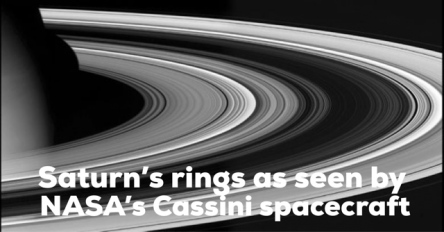 SATURN
SATURN
- Saturn is made of the same stuff as Jupiter and is 75,000 miles in diameter. It is also much further out from the Sun with an average distance of 886,526,100 miles.
- Saturn has 82 moons and they range in size from about the size of Mercury (Titan) to objects the size of a sports arena. Of course, if you want to include the tiny ice particles of the rings, then Saturn has millions of moons.
- The rings are composed ice particles and dust that are very good at reflecting light. The rings all orbit at different speeds, with the inner ones orbiting faster than the outer rings.
- There is a hexagonal-shaped hurricane at Saturn’s north pole. It is some 20,000 miles wide and has a retinue of smaller storms around it. Weird.
- Here on Earth, at our temperatures and atmospheric pressures, methane exists as a gas. But on Saturn’s moon Titan, it is a liquid and it covers the moon with seas and rivers of the stuff. It even rains liquid methane. Also weird.
That’s all for now, I hope you get outside and take a gander at these two planets this summer, and that you do so with both awe and wonder.